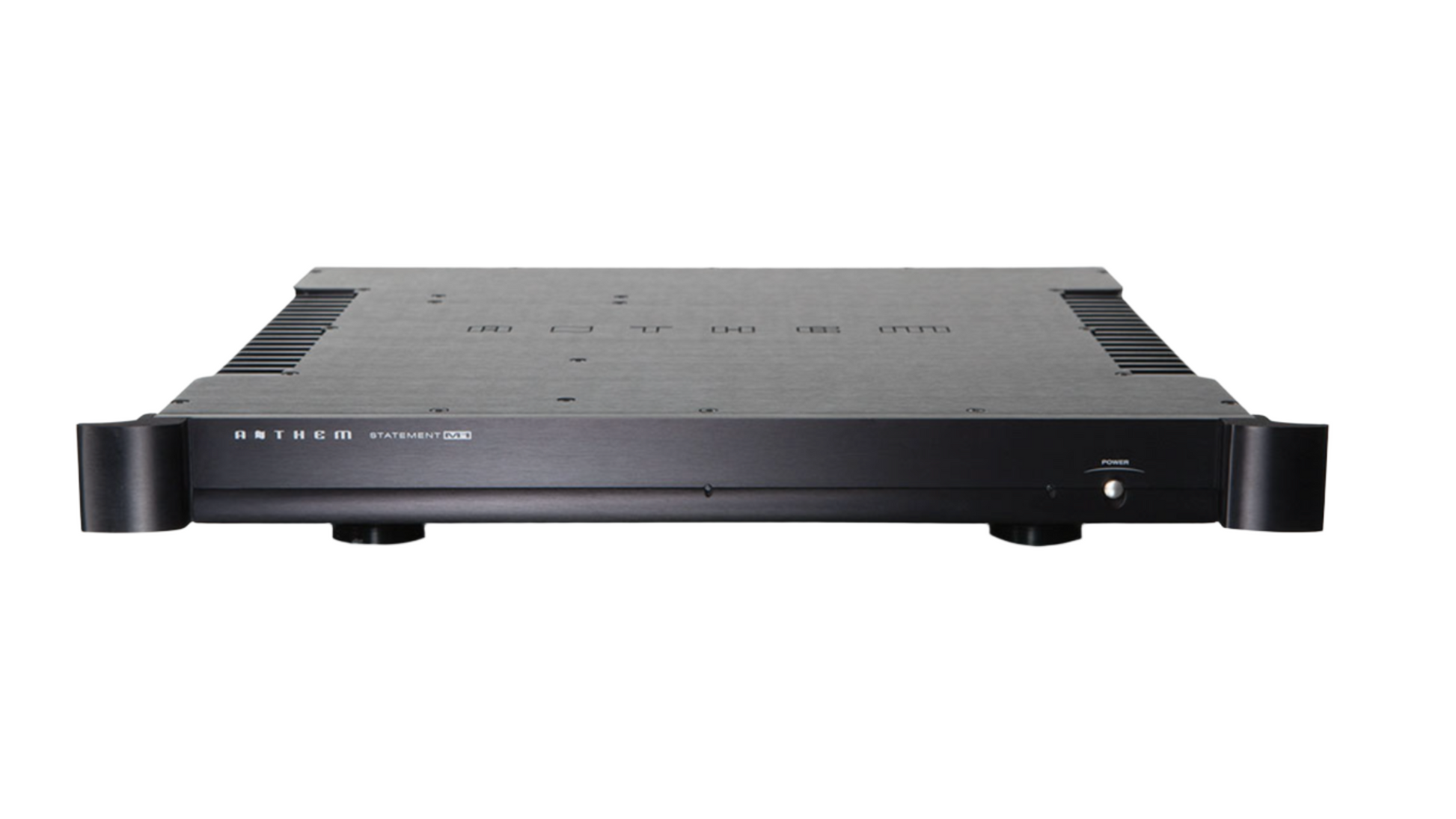
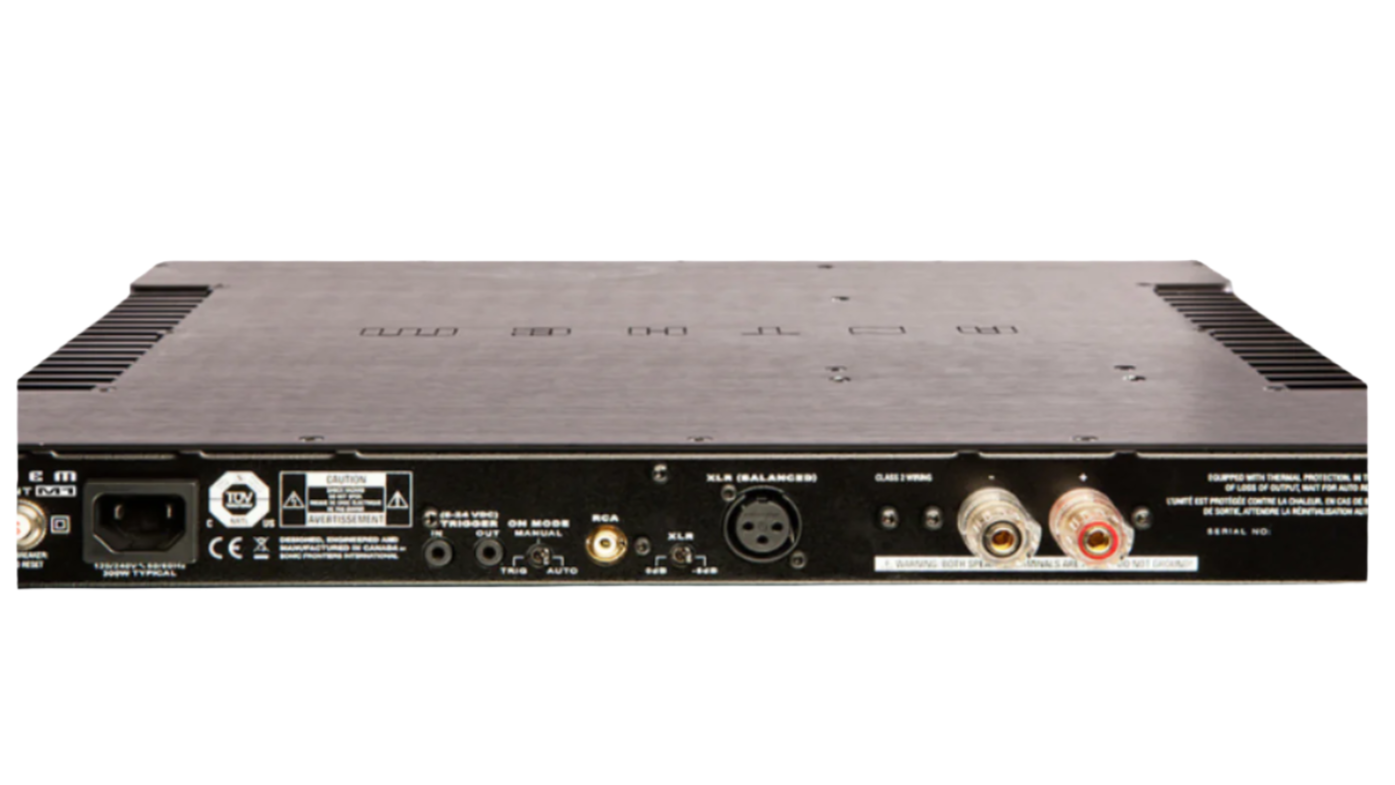
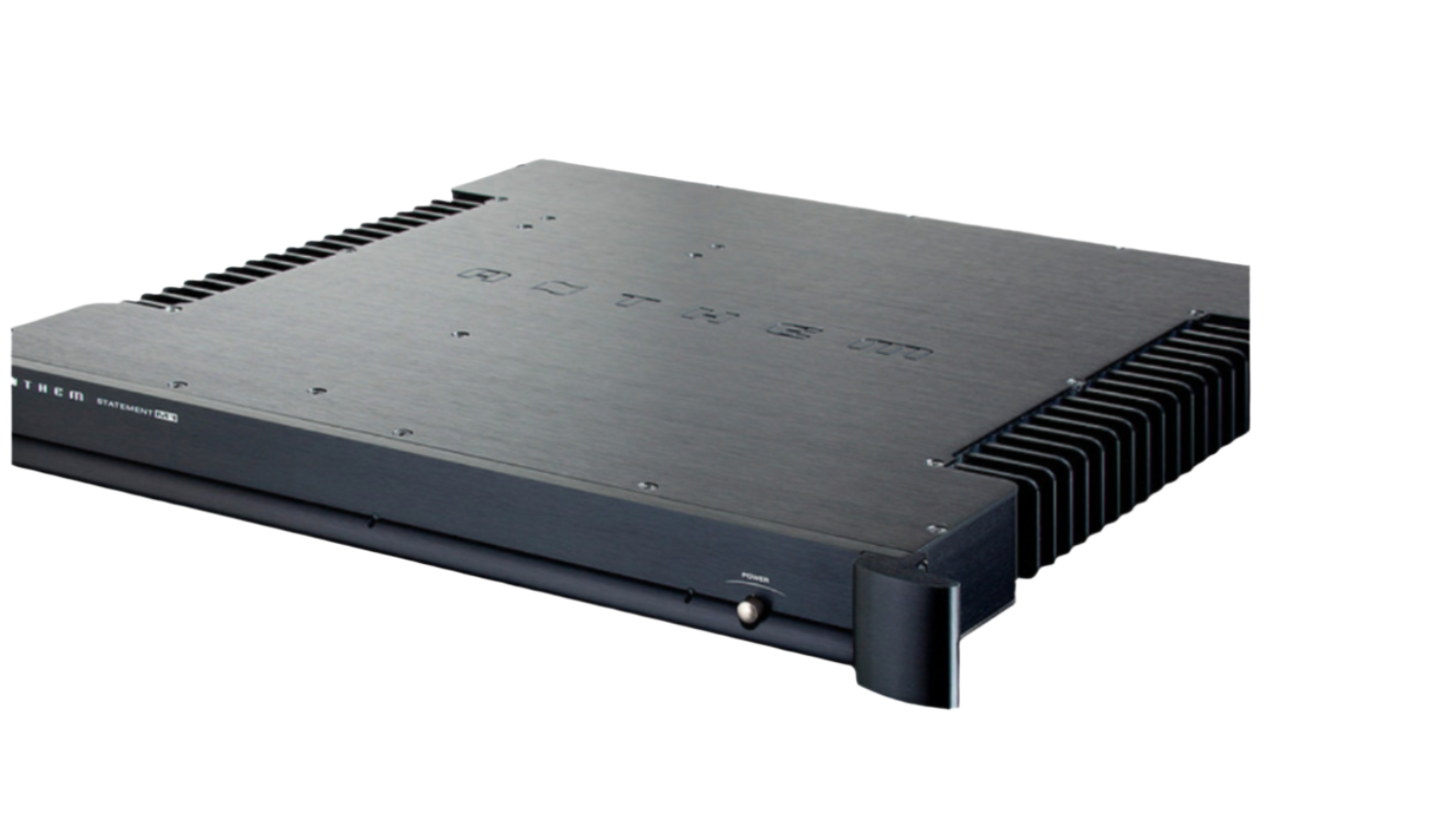
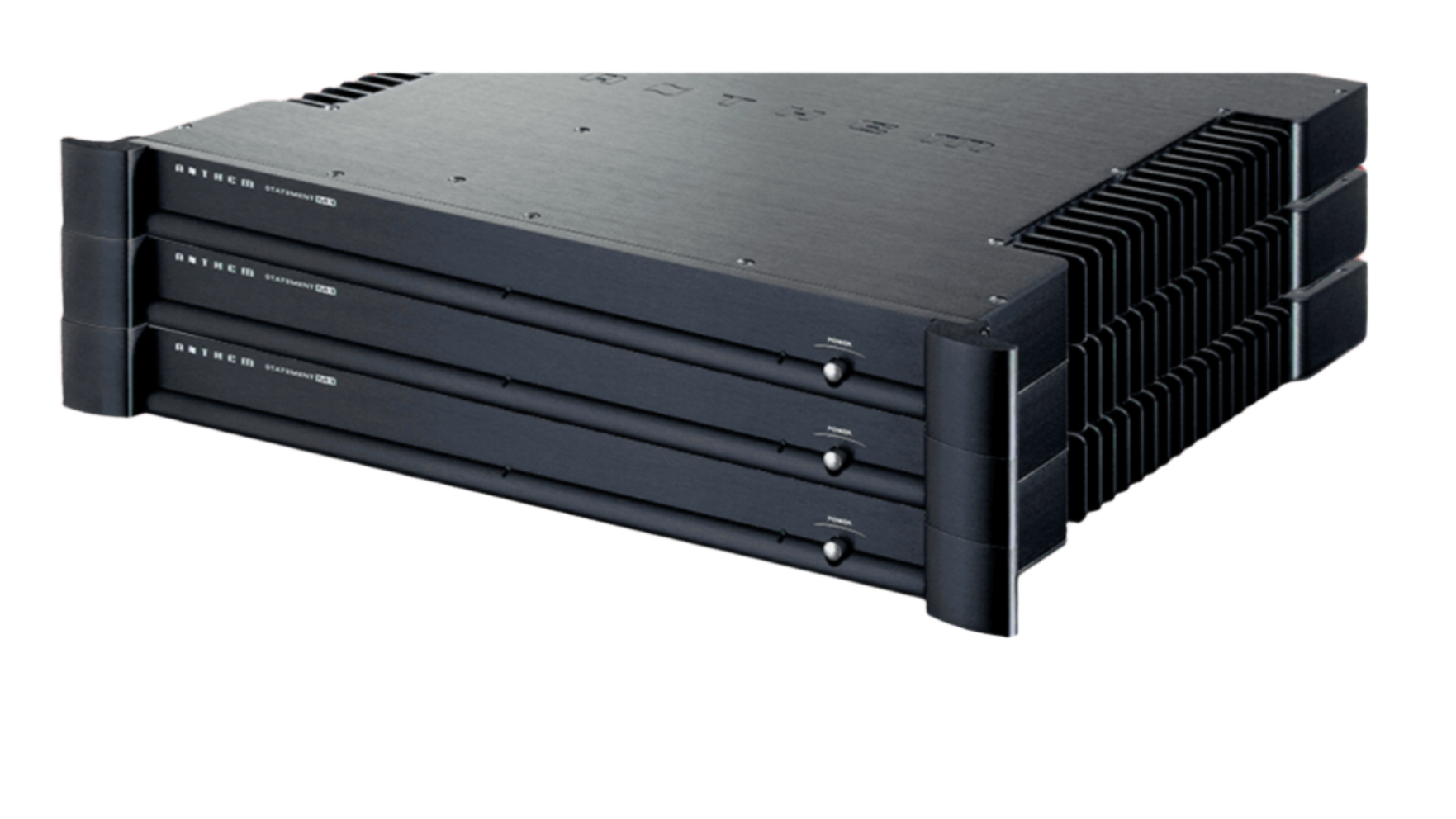
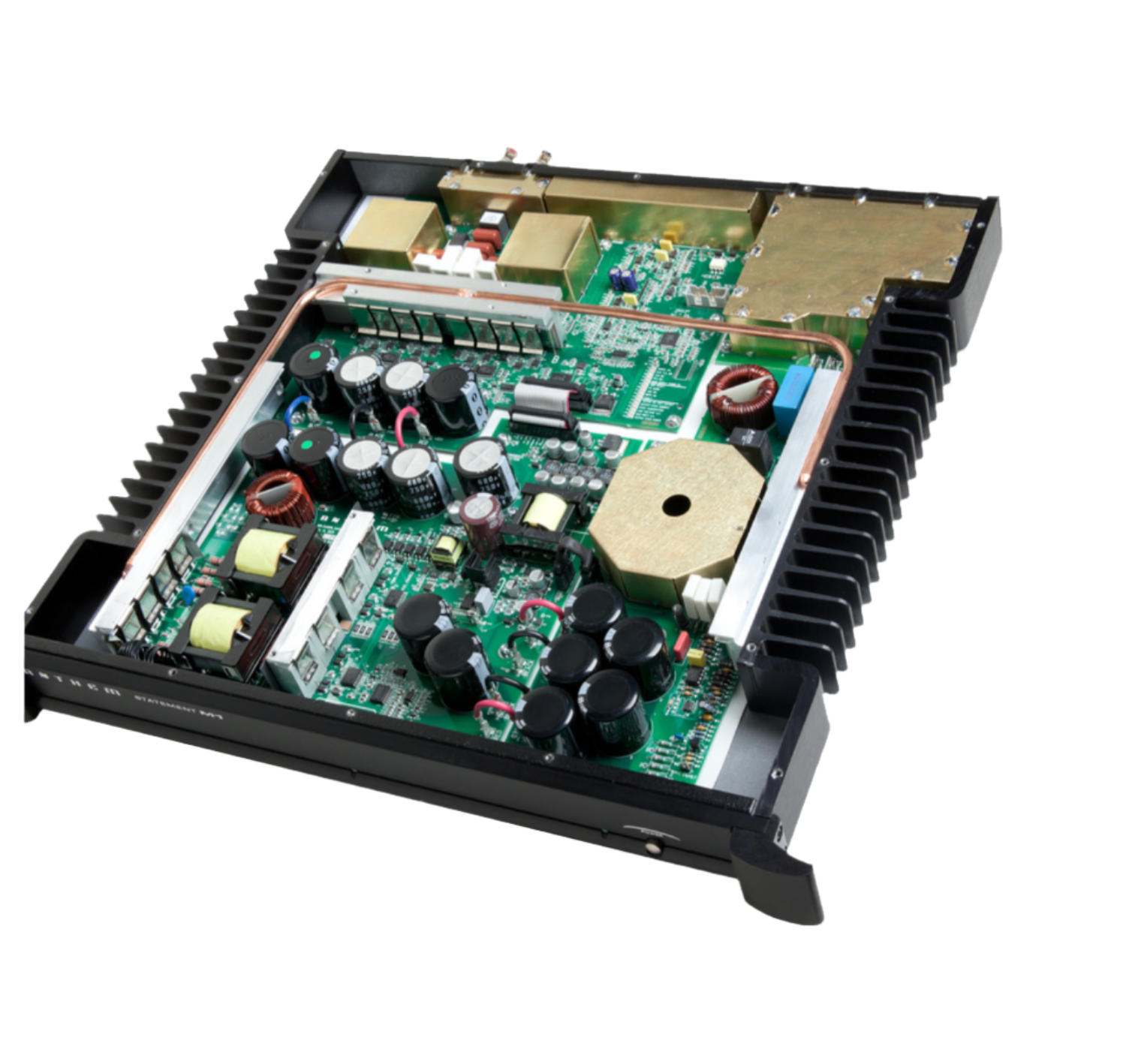
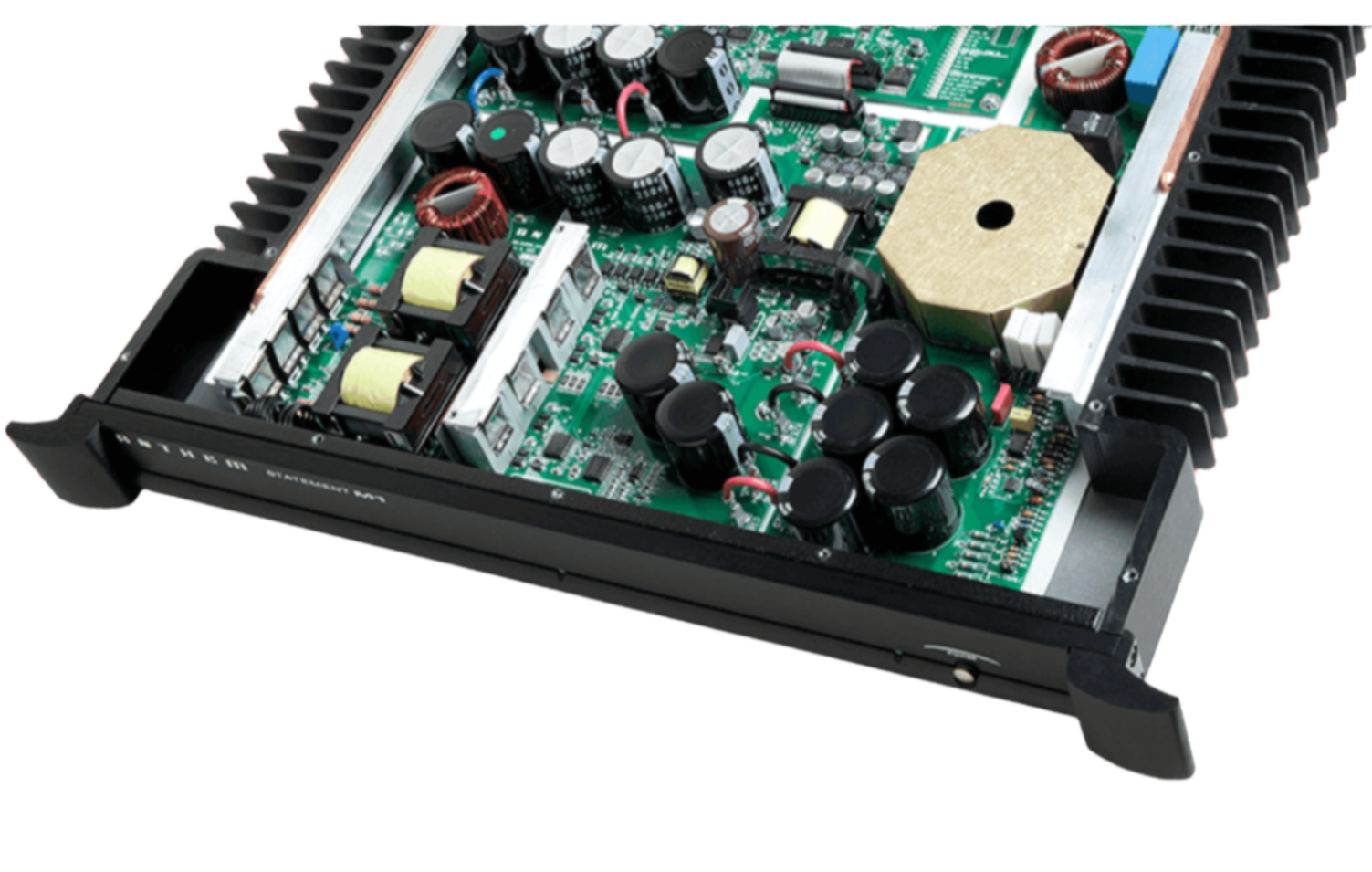






Anthem M -Series M1 Monoblock Power Amplifier
- Regular price
- Rs. 329,175.00
- Sale price
- Rs. 329,175.00
- Regular price
-
Rs. 438,900.00 - Unit price
- / per
- Best Anthem M -Series M1 Monoblock Power Amplifier
Couldn't load pickup availability
Description
State-of-the-Art Monaural Amplifier
The highest sound quality at all volume levels, flat frequency response into any load, and stable into the most difficult loads. The Statement M1 is a state-of-the-art monaural amplifier delivering 1,000 watts into 8 ohms and 2,000 watts into 4 ohms or less with THD remaining under 0.1% from 20Hz to 20 kHz. Designed and engineered in our advanced research center in Ottawa, Canada, the M1 is manufactured in our Toronto facility.
Best Value in the Market
The M1 enjoys all of the attributes of our award-winning Statement Class AB amplifiers but through exclusive Anthem technologies, goes far beyond the current capabilities of Class A, Class AB and prior Class D amplifiers in the market.
The proprietary design employs all of the advantages of a Class D amplifier — high output, high efficiency, compact size — while avoiding the typical Class D limitations such as difficulty driving low-impedance (high-end) speakers, power line contamination, reliability issues and substandard audio quality. The absence of accurate dynamics is so common that it frequently goes unnoticed, but through the M1, music and movies are delivered with breathtaking realism.
Slim Size, Beefy Power!
Never Judge an Amp by Its Size or Its Rack Space
Amplifiers are often judged by their size and weight, the beefier the better since more power requires a physically heavier, larger amplifier. Or does it? It all depends on the design. When rack-mounted, the 20-kb M1 occupies only one rack space but despite its size can deliver 1,000W into 8 ohms and 2,000W into 4 ohms.
Cool Running
The M1’s cooling system quickly and efficiently moves heat from the interior of the amplifier to exterior heat sinks. Sealed copper pipes within the amp contain a small amount of special fluid held under a vacuum. When the temperature at one end of the pipe rises — the end adjacent to the amplifier's heat sources — the fluid in that end evaporates. This vapor is then naturally drawn to the cooler end of the pipe, along the heat sink on the side of the amp’s chassis where it condenses. From there a copper wick returns the fluid to the hotter end of the pipe. This heat transfer process is many thousands of times faster and more efficient than cooling through metal heat sinks alone. This system eliminates the need for fans, allowing multiple M1s to be stacked with no danger of overheating. It also means the amplifier is so mechanically quiet it will suit even the quietest listening rooms.
No Noise is Good News
With an absence of noisy fans and a noise floor well below that of a high-end preamplifier, the M1 is a critical listener's dream.
Advanced Load Monitoring & Power Factor Correction
Proprietary Load Monitoring
The M1 has a very sophisticated load monitoring system. Two 100A Hall-Effect sensors monitor the output current. A Digital Signal Processor, outside the signal path, is used for power sequencing and to monitor various amplifier and power supply functions including line voltage, output current, ground fault detection, temperature and DC voltage at the output.
The M1’s output stage does not interact with the load. A hysteric PID controller which uses past, present and a predicted future to make adjustments keeps the amp load independent. Hundreds of computer simulations were used to test and optimize this system so that it is able to handle all possible loads. This is a significant design achievement. Whether you are running the M1 from a 120V circuit or a 240V circuit, the amplifier will be delivering the highest output possible according to the operating conditions.
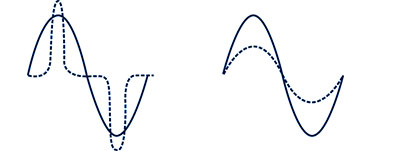
Left: Power supply without PFC. Current flows in short bursts and ends up much higher than it needs to be, limiting available power and increasing the chance of tripping a breaker.
Right: Power supply with PFC. The voltage and current waveforms are sinusoidal and in-phase.
Power Factor Correction
Power Factor Correction (PFC) maximizes available power and at the same time reduces (by a large amount!) the noise put on the AC line. Without PFC, the input current can flow and charge the capacitors only during the short moments that voltage is at or very close to its positive or negative peak. Since power is the product of both voltage and current it is produced only when both are present. Power Factor Correction marries the voltage and current cycles enabling continuous output from the power supply through the entire AC cycle. In doing so, the load appears almost purely resistive to the AC source. (See diagrams to right)
The Special Advantages of Bridged Mode Amplification in the M1
- Lower voltage MOSFETs can be used for lower resistance and higher speed. Although more expensive since more MOSFETs are needed, sound quality is vastly improved.
- Because the load is balanced, output current goes from one rail to the other without disturbing the ground plane. A balanced load also provides more efficient use of the power supply. Rail voltage is stable, unlike in single-ended Class D amps which suffer from rail pumping at low frequency and high power.
- Power supply capacitors become more efficient because bridging doubles the ripple frequency while impedance and ripple voltage are halved, allowing the power supply capacitors to be more efficient.
- For a high-power amp such as the M1, bridging can be safer. The differential output voltage can reach over 90 Vrms but at this level each output terminal is only 45 Vrms with respect to the chassis.
Additional High-End Touches
- Hand-designed 4-layer FR4-rated glass-epoxy circuit board with 2-ounce copper traces promotes exceptional conductivity.
- Extensive use of power and ground planes ensures vanishingly low levels of noise and inductance to produce an amp that gets out of the way, leaving only the sound of the music.
- Each of the eight 65-amp MOSFETs can handle a peak current of 260 amperes, has low gate charge for fast response, low channel resistance for high efficiency and high speed for high efficiency and low distortion.
- No relays are used in the signal path preventing any possibility of relay failure.
Why Doesn’t the M1’s Power Cord Have a Third Prong?
Although more difficult and expensive to implement, Anthem has always used 2-prong AC cords to make installation easier.
A 3-prong cord is prone to ground loops if the system includes other 3-prong equipment or cable/satellite TV. For example: If the preamplifier uses three prongs it is grounded not only through its power cord but also through any non-optical connections to other 3-prong components. This can result in humming or buzzing through the speakers as well as video noise problems. The more elaborate the system, the greater the chance of a ground loop. With 3-prong equipment, balanced XLR inter-connection is needed throughout and that type of interconnection is not always possible.
With a 2-prong cord, safety is maintained through either double or reinforced insulation. The next time you see a corded power tool, look for the double-square symbol. It requires more expensive wires on the live side and greater distance between live circuits and isolated circuits and chassis. The distance requirement also applies to spacing inside transformers, making them larger and more expensive. A 2-prong cord also requires a larger line filter because according to safety standards the line-chassis leakage current limit is ten times lower compared to 3-prong. Ironically, a higher leakage current allowance aggravates hum problems in 3-prong systems.
To clear up any final misconceptions, the earth ground provided by the third prong is not meant as a shield, it is a safety measure meant to trip breakers should a chassis become live as a result of coming into contact with a live wire.
Fact!
The “D” in Class D does not stand for digital. It was simply the fourth type of amp recognized and classified by the IEEE. The first was Class A, the second Class B, the third Class C, etc.
Not All Class D Amplifiers are Created Equal!
In the audio press and across the Internet many generalizations have been made about deficiencies in Class D amplifier design. While such generalizations may hold true for other brands of amplifiers, below, Anthem responds to each one as it relates to our M1.
| Generalization | M1 Response |
|---|---|
|
Class D amps have high radio-frequency emissions |
Emissions are well within EMC Class B requirements, which are stricter than Class A requirements for residential use. |
|
Frequency response is affected by input circuits sensitive to stray high-frequency signals |
Frequency response in the M1 is +/- 0.1 dB from 20 Hz to 20 kHz, and -3 dB at 45 kHz, well beyond the limit of audibility. |
|
Frequency response is affected by feedback not accounting for output filter effects |
Feedback is after the output filter, thus already accounting for these effects. |
|
Class D amps have poor high-frequency resolution and high intermodulation distortion |
The M1’s high-speed control loop includes high-speed instrumentation-grade op-amps and CMOS Logic gates, solving these issues. |
|
Class D amps negatively affect dynamic variations in clarity and focus |
In blind listening tests, the M1 was shown to provide consistent audiophile sound with clear, focused sound. |
|
High-feedback switch-mode power supplies cause power draw variations |
The M1 uses a linear supply that replenishes bus capacitors 200,000 times per second, ensuring stable output. |
|
Class D amps have shaped noise floors that vary with signal level |
The M1’s noise floor is virtually inaudible. |
|
Class D cannot resolve detail well, with SACD’s DSD running at 2.8 MHz |
DSD is pulse density modulation (not pulse width modulation). The M1 operates at a frequency of 0.4 MHz with time resolution down to around 4 nanoseconds, 87.5 times better than SACD. |
|
High DC potential is present on Class D output stages |
The M1’s outputs idle at ground potential (0V). |
|
A dynamic range compressor may impair clarity |
The M1 does not use a compressor, and its output stage never clips. |
|
Class D amplifiers suffer from ‘dead time’ and crossover distortion |
The M1 has no audible effects from ‘dead time.’ Its timing is controlled by high-speed Advanced CMOS Logic gates with very low propagation delay. |
|
Class D output stages have thermal dissipation issues |
The M1 does not use a module; its discrete operation features output MOSFETs mounted on a copper-clad PCB and a heavy aluminum extrusion with heat pipes. |
|
Class D output stages are fragile and current-limiting affects sound quality |
The M1’s output stage is robust with eight 65-ampere MOSFETs (260A peak), and if over-current occurs, it simply shuts down. |
|
Stability is conditional; some Class D amps can oscillate under no load |
The M1 is stable into any load, including open circuits and short circuits, and will only shut down if the current limit is reached. |
This table covers the generalizations made about Class D amplifiers and how the M1 addresses each one.
Power Output at Different Impedances
|
Specification |
Value |
|---|---|
|
Power Output (3 ohms) |
2,400 W |
|
Power Output (4 ohms) |
2,000 W |
|
Power Output (8 ohms) |
1,000 W |
This summarizes the power output of the M1 at different impedances. These figures are continuous from 20 Hz to 20 kHz at less than 0.1% THD+N. The M1 can deliver 2 kW continuously when fed by 240V mains and 2 kW for several seconds when fed by a dedicated 120V 15A line.
Input -Output and Auto-on Features
| Specification | Value |
|---|---|
|
Inputs |
RCA, XLR, Trigger |
|
Outputs |
Trigger, Binding Post |
|
Auto-on |
Powers on/off via trigger or input signal detection. Automatically turns off after a few minutes with no signal. |
Cutting Edge Technology & Design
| Feature | Description |
|---|---|
|
Full Resolution |
Captures all sonic subtleties and complexities in the input signal. |
|
Dynamic Range |
Accurate reproduction of the full dynamic range of the signal. |
|
Output Stage |
Ensures the output stage never clips. |
|
Compression |
No compression occurs as output increases. |
|
Frequency Response |
Maintains a flat frequency response into any load without digital conversion. |
|
Load Stability |
Stable into all loads, including open circuit and short circuit. |
|
Noise Floor |
Maintains a low noise floor for clearer audio. |
|
Efficiency |
Exceptional efficiency with low heat output. |
|
Mechanically Silent |
The amp is so quiet, it suits even the quietest listening room. |
|
Stackable Design |
Can be stacked with no danger of overheating. |
|
Price-to-Performance Ratio |
Delivers limitless dynamic fidelity at a reasonable price point. |
Features
| Feature | Description |
|---|---|
|
New Electronics Platform |
Up to 15.2 channels, HDMI 2.0b HDCP 2.2, hardware upgradeable to HDMI 2.1 (8K) |
|
Updated Audio Codecs |
Latest version of DTS:X and Dolby Atmos |
|
DTS:X Pro |
On select models (MRX 1140, AVM 90 and AVM 70), updated to the latest version of DTS:X Pro |
|
IMAX Enhanced |
Enhanced with IMAX technology |
|
ARC Genesis Sub Outputs |
Two independent subwoofer outputs on AVM 70 for frequency response and phase alignment |
|
HDMI Zone 2 Output |
Independent HDMI Zone 2 output |
|
ARC Genesis Microphone |
Features a more precise microphone for better calibration results |
|
Streaming Platforms |
AirPlay2, Google Chromecast (Audio), Bluetooth v4.2, Spotify Connect (coming soon), Roon (coming soon) |
|
Reliable Networking Platform |
Web-based setup and over-the-air updates |
|
Next-Gen DSP Platform |
Advanced DSP platform for enhanced audio |
|
Modernized Design |
High-resolution front panel display |
|
MM Phono Stage |
High-quality MM phono stage |
Audio Features
| Feature | Description |
|---|---|
|
Pre-amplifier Channels |
2 pre-amplifier channels |
|
Independent Subwoofer Outputs |
Two independent subwoofer outputs |
|
Auto Subwoofer Phase Adjustments |
Automatic phase adjustments via ARC Genesis |
|
Auto Subwoofer Polarity Adjustments |
Automatic polarity adjustments via ARC Genesis |
|
ARC Genesis Implementation |
Latest implementation of ARC Genesis for enhanced audio calibration |
|
Speaker Profile Memories |
Four speaker profile memories |
|
Speaker Distance Increments |
2” / 5 cm speaker distance increments |
|
Level Increments |
5dB level increments |
|
Super Sub Front Setting |
Optimized front setting for subwoofer |
HDMI & Video Features
| Feature | Description |
|---|---|
|
Dolby Vision |
Supports Dolby Vision for enhanced video |
|
IMAX Enhanced |
Enhanced with IMAX video technology |
|
HDMI 2.0b & HDCP 2.2 |
HDMI 2.0b & HDCP 2.2 (upgradeable to HDMI 2.1 8K) |
|
HDMI eARC |
Enhanced Audio Return Channel (eARC) support |
|
4:4:4 Subsampling @4K60 |
18.2 Gbps bandwidth at 4K 60Hz |
|
High Dynamic Range (HDR) |
Supports HDR for improved video quality |
|
Hybrid Log Gamma (HLG) |
Supports HLG for better contrast and color |
|
2020 Color Gamut |
Supports wide color gamut for improved color accuracy |
|
4K 50/60 Switching |
Seamless switching between 4K 50/60 video signals |
|
Zone 2 HDMI Output |
Zone 2 HDMI output for multi-zone setups |
|
Dual HDMI Outputs |
Two HDMI outputs for flexible video distribution |
|
Standby Pass-Through |
Pass-through video signal in standby mode |
Decoding Features
| Feature | Description |
|---|---|
|
Dolby Atmos |
Supports Dolby Atmos surround sound |
|
Dolby HD |
Supports Dolby HD audio formats |
|
DTS:X Pro |
Supports DTS:X Pro for immersive sound |
|
DTS:X |
Supports DTS:X for object-based sound |
|
DTS-HD Master Audio |
Supports DTS-HD Master Audio for high-definition sound |
Custom Installation
| Feature | Description |
|---|---|
|
IP Control |
IP control for network-based integration |
|
RS-232 Control |
RS-232 control for system integration |
|
IR Input |
IR input for remote control integration |
|
12V Trigger Outputs |
Three 12V trigger outputs for system automation |
|
Premade Control Drivers |
Includes pre-made control drivers for easy setup |
|
Save and Load Settings |
Option to save and load system settings |
|
Import and Export Settings |
Ability to import and export settings |
|
Rackmount Kit |
Rackmount kit sold separately for installation flexibility |
Streaming Features
| Feature | Description |
|---|---|
|
Google Chromecast Audio |
Streaming support via Google Chromecast Audio |
|
Bluetooth |
Bluetooth support for wireless audio streaming |
Listening Modes
| Mode | Description |
|---|---|
|
Anthem Logic |
Optimized listening mode for dynamic sound |
|
Dolby Surround |
Surround sound decoding for Dolby formats |
|
DTS Neural :X |
Neural:X processing for immersive sound |
|
DTS Virtual :X |
Virtual:X processing for 3D sound experience |
|
Stereo |
Traditional stereo sound |
|
All Channel Stereo |
All channels output stereo sound |
|
Mono |
Mono sound for single-channel audio |
|
All Channel Mono |
All channels output mono sound |
Additional Features
| Feature | Description |
|---|---|
|
Anthem Web User Interface |
Web-based interface for easy system control |
|
Toroidal Transformer |
High-efficiency toroidal transformer for power supply |
|
30 Input Configurations |
30 input configurations for versatile system setups |
|
Input Trim Adjustments |
Fine-tune input levels with trim adjustments |
|
Power-on Input Assignment |
Automatically assign the input upon power-on |
|
Auto Power Off |
Auto power off feature to save energy |
|
Eco Mode |
Eco mode for low-power standby operation |
|
Over-the-air Network Updates |
Network-based updates for system software |
|
USB Updates |
Software updates via USB port |
|
Beta Updates |
Beta updates available over-the-air |
|
Backlit Remote Control |
Backlit remote control for easy operation |
M1 Specifications
Power Output
| Specification | Description |
|---|---|
| Power Output | (Continuous, 20 Hz to 20 kHz, <0.1% THD+N) |
| 8 Ω | 1000 W |
| 4 Ω | 2000 W |
| 3 Ω | 2400 W |
| 2 Ω | >2000 W (depending on line voltage regulation) |
With 120V AC supply the amplifier’s maximum output into impedances 4 Ω and lower, as well as its maximum duration, vary depending on line voltage regulation.
Frequency Response
| Specification | Description |
|---|---|
| Frequency Response | 20Hz to 20 kHz |
| Open Circuit | +/- 0.1 dB |
| 8 Ω | +/- 0.1 dB |
| 4 Ω | +/- 0.1 dB |
| 2 Ω | +/- 0.2 dB |
Power Bandwidth
| Specification | Value |
|---|---|
|
Power Output |
1000 W |
|
Impedance |
8 Ω |
|
Frequency Range |
5 Hz to 45 kHz |
Total Harmonic Distortion plus Noise (THD+N) values at 1 kHz and 8 Ω
| Power Output | THD+N at 1 kHz, 8 Ω |
|---|---|
| 1 W | 0.01 % |
| 10 W | 0.01 % |
| 100 W | <0.03 % |
| 1000 W | <0.06 % |
Additional Parameters for the Device
| Specification | Value |
|---|---|
|
IMD (19 kHz + 20 kHz, CCIF) |
0.003% |
|
S/N Ratio (ref. 1000 W, IEC-A) |
113 dB |
|
Voltage Gain |
29 dB |
|
Input Sensitivity |
100 mV for 1 W, 3.2 V for 1000 W (8 Ω) |
|
Input Impedance |
10 kΩ (RCA), 20 kΩ (XLR) |
|
Damping Factor |
800 to 1400 depending on frequency |
|
XLR Configuration |
Pin 1: Ground, Pin 2: Positive, Pin 3: Negative |
Power Requirements
| Specification | Value |
|---|---|
| Consumption in Standby Mode (120V mains) | <1 W |
| Consumption in Standby Mode (240V mains) | <2 W |
| Consumption in Operate Mode, Idle | 33 W |
| Consumption in Typical Operation | 300 W |
Where mains voltage is 120V, one dedicated 15A circuit per amplifier is recommended depending on speaker. A 20A circuit is adequate for two amplifiers playing music where speaker impedance is 8 Ω. This product operates from a single phase AC power source that supplies between 108V and 264V at a frequency of 50 or 60 Hz.
Weight
| Specification | Value |
|---|---|
|
Height with Feet |
2 1/4 inches (5.7 cm) |
|
Height without Feet |
1 rack unit |
|
Width (Standard Handles) |
19 1/4 inches (49 cm) |
|
Width (Rackmount Handles) |
19 inches (48.3 cm) |
|
Depth |
18 3/4 inches (47.6 cm) |
|
Weight (Unpacked) |
20 lb (9 kg) |






Up to 10 Years of Hassle-Free Warranty.
Many sellers offer products without service, but we’ve got you covered. Contact us to book your warranty, drop it in-store, or ship it to us for a refund or exchange for up to 10 years.
Book Your Private Cinema Experience

